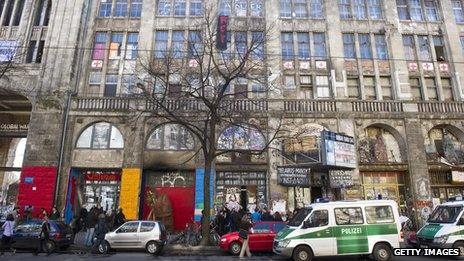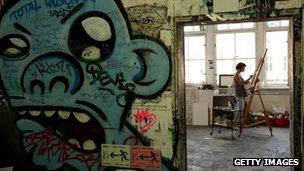Authorities shut Berlin's iconic Tacheles arts squat
- Published

Built in 1907, the Tacheles arts centre became a central office for Hitler's Nazi Party during the 1930s
Berlin's iconic Tacheles arts centre has been cleared after decades of bureaucratic wrangling over the debt-ridden building.
The massive warehouse in the Mitte district was occupied by artists after the fall of the Berlin Wall and became a major tourist attraction.
But the dilapidated complex has been hampering local redevelopment plans.
HSH Nordbank, currently in charge of the Tacheles, external, requested the clearance as part of plans to sell the centre.
Situated in what used to be East Berlin, when the city was divided by the wall, the building stretches over 1250sq m (13,455sq ft) and houses a theatre, cinema, restaurant, as well as a maze of galleries and workshop areas.
Before police arrived, two black-clad artists played a funeral march but bailiffs were able to clear the building without resistance, the AFP news agency reported.
"This is the theft of a work of art, supported by the police," Tacheles spokesman Martin Reiter told a small gathering of supporters and journalists outside the building.
'Artistic colonisation'
The five-storey building has experienced a tumultuous history since it first opened its doors as an elegant shopping arcade in 1909.
When the department store went bankrupt in 1928, it was sold to the German engineering company AEG.
Shortly afterwards, the Nazi Party took over the building and turned it into a central administrative office. Prisoners of war are said to have been held in the attic for interrogation purposes during World War II.
Decades later, East German authorities tore down large chunks of the building in the 1980s but were unable to start new construction due to a lack of funds.

Many internationally renowned artists have exhibited their works at the centre
One part of the original Tacheles complex remained and was taken over by squatting artists who had resisted eviction efforts - until now.
The address quickly became a thriving hub of alternative culture, which drew stars like choreographer Sasha Waltz and musician Peaches who regularly rehearsed and performed there.
For sustainable urban planning expert Dr Daniel Dahm, this "artistic colonisation" of East Berlin's empty spaces is a healthy development.
"There are approximately 200,000 empty houses and flats in East Berlin as a result of German reunification," he said.
"The Arthouse Tacheles is an example of self-motivated work by citizens who decided to proactively stand up for their ideals."
The City of Berlin eventually sold the Tacheles to the Fundus investment company, which planned to demolish the warehouse and build modern apartment blocks in its stead.
But the project never materialised and the arts centre eventually fell into the hands of HSH Nordbank, which decided to sell it.
- Published29 March 2012
- Published6 August 2012